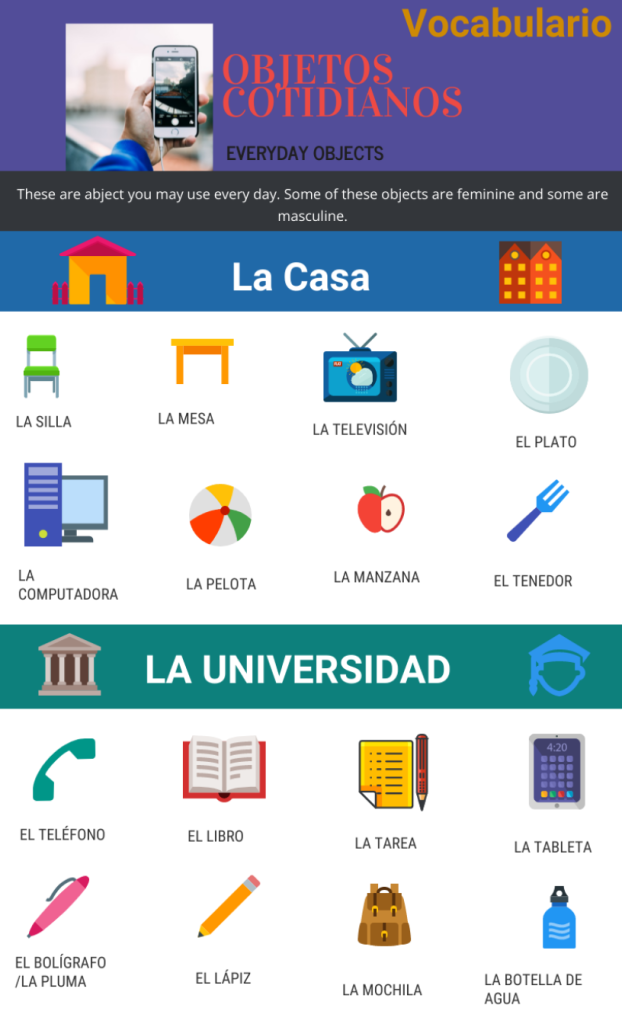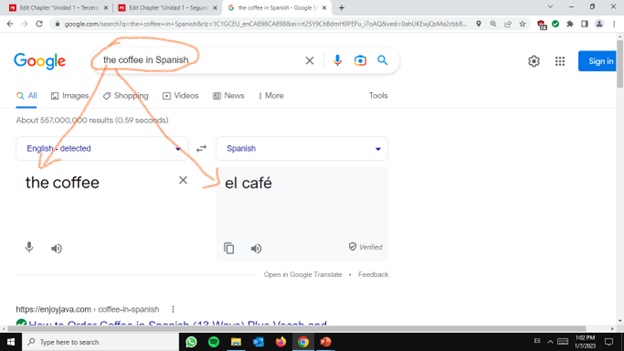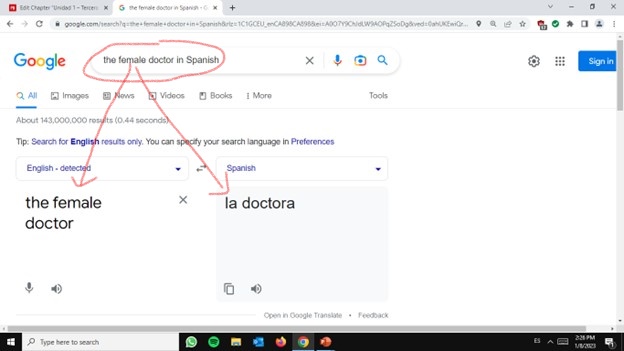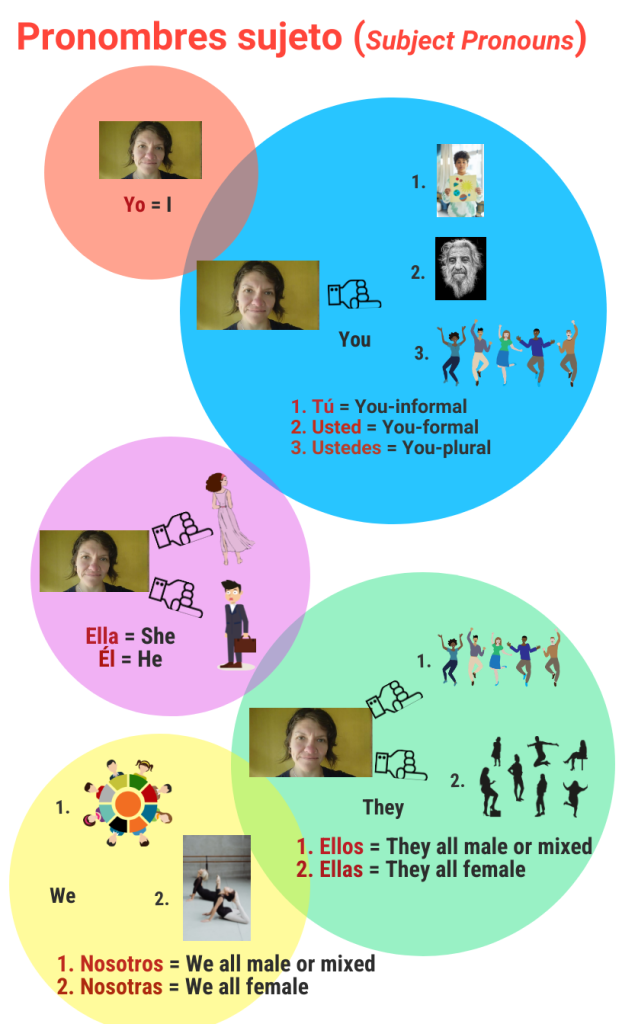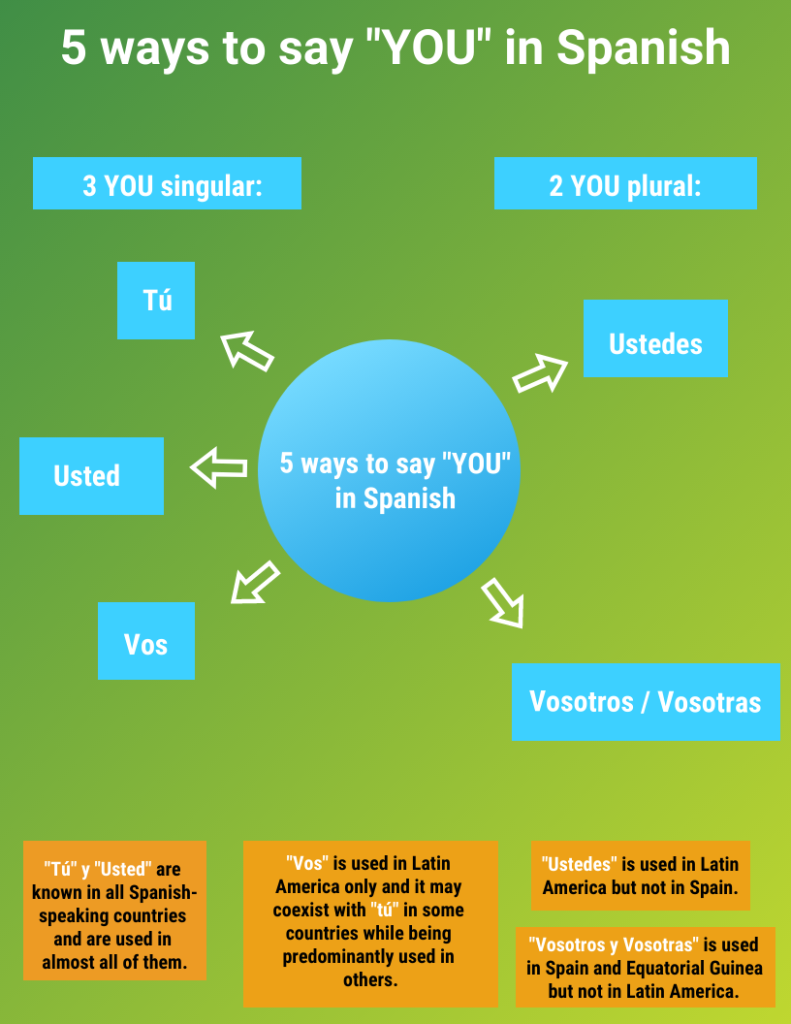Unidad 1 – Tercera Parte (Part 3)
Vocabulario
(Vocabulary)
Los objetos cotidianos (Everyday objects)
| Objetos femeninos | Obejetos masculinos |
|---|---|
| la casa / una casa | el plato / un plato |
| la silla / una silla | el tenedor / un tenedor |
| la televisón / una televisión | el teléfono (celular) / un teléfono (celular) |
| la computadora / una computadora[1] | el libro / un libro |
| la pelota / una pelota | el bolígrafo / un bolígrafo[2] |
| la manzana / una manzana | el lápiz / un lápiz |
| la tarea / una tarea | |
| la tableta / una tableta | |
| la mochila / una mochila | |
| la botella de agua / una botella de agua |
¡IMPORTANTE!
- Las palabras (the words) la / una means the / a, an in English when used with singular feminine objects (or nouns) in Spanish.
- Las palabras el / un means the / a, an in English when used with singular masculine objects (or nouns) in Spanish.
- Las palabras la / una, el / un can also be used with singular persons (or nouns) so they also apply to identify the list of el vocabulario de las personas studied earlier.
¡A practicar! (Let´s practice!)
Expand your vocabulary of objetos en español (objects in Spanish) that are important to you by doing a Google search in English as follows:
By adding the or a/an in your search in English, you will gain knowledge of both the vocabulary word in Spanish and its gender (femenino / masculino).
Create a list of objetos and memorize them in Spanish along with their gender. This will be very useful as you continue learning and using español (Spanish).
Gramática
(Grammar)
1. Sustantivos y género gramatical en español
(Nouns and grammatical gender in Spanish)
Sustantivos (nouns) are words that classify things into categories. For example, las personas (people), los objetos (objects), los lugares (places), los animales (animals), las frutas (fruits), los conceptos (concepts), etc. In Spanish los sustantivos can be:
- Singular words. For example: la profesora, una profesora / el amigo, un amigo
- Plural words. For example: las profesoras, unas profesoras / los amigos, unos amigos
- Femenine words when preceded by the articles la, una, las, unas
- Masculine words when preceded by the articles el, un, los, unos
Cómo identificar el género gramatical de un sustantivo
(How to identify a noun´s grammatical gender)
Most feminine nouns end in _a, _ción, _xión, _sión, _dad, _tad. For example: la/una tarea (homework), la/una estación (station), la/una reflexión (reflection), la/una transmisión (transmission), la/una universidad (university), la/una amistad (frienship)
Most masculine nouns end in _o, _ma, _r. For example: el/un teléfono (telephone), el/un problema (problem), el/un tenedor (fork)
Nous that end in _e can be either femininos o masculinos (feminine or masculine):
- If the noun ending in _e is identifying una persona (a person) the articles before the noun will follow the gender or sex of the person. For example:
- If the noun ending in _e is identifying un objeto (an object) the grammatical gender of the noun can vary. For example: el/un café (coffee), la/una tarde (afternoon), la/una noche (night), la/una leche (milk), el/un tomate (tomato).
¡IMPORTANTE!
- There will always be exceptions to the rules above. Hence, it is MUY IMPORTANTE (very important) that you always check the gender of a sustantivo en español (noun in Spanish) by doing a Google search in English as learned in the blue section vocabulario above.
- El español is gender-sensitive when identifying sustantivos para personas (nouns for persons). Hence, it is equally IMPORTANTE that any Google search in English integrates the person´s gender/sex so your translation en español will be gender, especially for females[5]. For example:
2. Los pronombres sujeto en español (Subject pronouns in Spanish)
¡IMPORTANTE!
Cómo usarlo
(How to use it)
Los pronombres sujeto (subject pronouns) tell us who is doing an action in the sentence.
Por ejemplo (for example):
- Yo soy Constanza (I am Constanza)
- Ella tiene 39 años (She is 39 years old)
- Nosotras somos mujeres (We [females] are women)
- Nosotros somos hombre (We [males] are men)
- Ellos son hombres (They [males] are men)
- Ellas son mujeres (They [females] are women)
- Usted es la profesora de español (You [formal] are the female Spanish teacher)
- Tú eres mi amigo (You [informal] are my male friend)
Los pronombres sujetos replace a subject person in the sentence.
Por ejemplo:
- Justin Trudeau es el Primer Ministro de Canadá. Él es el Primer Ministro de Canadá.
- La profesora de español es chilena y canadiense. Ella es chilena y canadiense.
- Mis amigas están muy bien. Ellas están muy bien.
- Mis amigos están bien. Ellos están bien.
¡IMPORTANTE!
If you are talking directly to a person whose identity or social role requires formal treatment you will use el pronombre sujeto usted.
Por ejemplo:
- Usted es la profesora de español. (You-formal is the Spanish teacher)
- Usted es el Primer Ministro de Canadá. (You-formal is the Prime Minister of Canada)
- Usted es el presidente de la asociación (You-formal is the President of the asociation)
If you are talking directly to a person whose identity or social role requires informal treatment you will use el pronombre sujeto tú.
Por ejemplo:
- Tú eres mi amiga. (You-informal are my female friend)
- Tú estás muy bien. (You-informal are very well)
- Tú tienes 5 años. (You-informal are 5 years old)
If you are talking directly to a group of 2 or more people you will use el pronombre sujeto ustedes.
Por ejemplo:
- Ustedes son personas de Argentina. (You-all are people from Argentina)
- Ustedes están contentos. (You-all males are happy)
- Ustedes tienen muchos objetos. (You-all have many objects)
¡A practicar! (Let´s practice!)
3. El presente simple indicativo de los verbos ser, tener, estar
(Simple present tense of verbs ser, tener, estar)
El presente simple indicativo en español
(Simple present tense in Spanish)
As in English, el presente simple indicativo en español tells that an action happens in the present.
For example:
- Yo soy Constanza (I am Constanza). Yo tengo 50 años (I am 50 years old). Yo estoy muy bien (I am very well).
The following table shows you how to conjugate 3 verbs (verbos) in Spanish in presente simple indicativo. These verbs are: Ser, Estar, Tener.
| Pronombres Sujeto | Ser | Estar | Tener |
|---|---|---|---|
| Yo | soy | estoy | tengo |
| Tú | eres | estás | tienes |
| Él, Ella, Usted | es | está | tiene |
| Nosotros, Nosotras | somos | estamos | tenemos |
| Ustedes, Ellos, Ellas | son | están | tienen |
¡IMPORTANTE!
- Because in Argentina, Uruguay, Paraguay and some countries in Central America, tú changes to vos, then tú eres, and tú tienes will change to vos sos, vos tenés.
- Because in Spain and Equatorial Guinea ustedes changes to vosotros / vosotras, then ustedes son, ustedes están, ustedes tienen will change to vosotros / vosotras sóis, estáis, tenéis.
-
Verbos Ser y Estar (Verbs Ser and Estar)
- Unlike English, el español has 2 verbos (verbs) in infinitive that means To be. These verbos are Ser and Estar.
- Since Ser and Estar are different verbos, they can't be used interchangeably as they have their own specific uses.
Cómo usar Ser
(How to use Ser)
El verbo Ser (verb Ser) has many specific uses. In this unidad 1 (unit 1) we will focus on:
- La identidad (Identity) as in:
- Yo soy Constanza Rojas-Primus. Yo soy una mujer.
- El Primer Ministro de Canadá es Justin Trudeau. Él es un hombre.
- Ana Robles y Cristina Ugalde son mujeres.
- País de origen[6] (Country of origin) as in:
- Justin Trudeau es de Canadá.
- La profesora de español es de Chile.
- Lionel Messi y Diego Maradona son de Argentina.
- La profesión u ocupación (profession or occupation) as in:
- Ana Robles y Cristina Ugalde son profesoras de español.
- Mi amiga Paulina es la presidente de la asociación.
Cómo usar Estar
(How to use Estar)
El verbo Estar (verb Estar) has many specific uses. In this unidad 1 (unit 1) we will focus on:
- Ánimos cotidianos (Everyday Moods) as in:
- Yo estoy excelente.
- El Primer Ministro de Canadá está terrible.
- Ana Robles y Cristina Ugalde están muy bien.
- Mi amiga Paulina está regular.
¡A practicar! (Let´s practice!)
¡Más práctica! (More practice!)
Based on the material studied translate the following sentences from English into Spanish. The context to use either Ser or Estar is given to you in parenthesis at the end of each sentence. Remember to conjugate Ser or Estar in el presente simple indicativo (simple present tense). Use the table studied above on how to conjugate these verbs in el presente simple indicativo in a sentence.
Copy and paste the following letters and symbols as needed.
á é í ó ú ñ Á É Í Ó Ú Ñ ¡ ! ¿ ?
| 1. He is Juan Peña. (Identidad) | |
| 2. She is from Spain. (País de origen) | |
| 3. You all are well! (Ánimos cotidianos) | |
| 4. I am Constanza. (Identidad) | |
| 5. He is a Professor. (Profesión u ocupación) | |
| 6. The girlfriends are Paulina y Rosa. (Identidad) | |
| 7. We are women. (Identidad) | |
| 8. Justin Trudeau is not so good. (Ánimos cotidianos) | |
| 9. You-formal are terrible. (Ánimos cotidianos) | |
| 10. They males are men. (Identidad) |
2. El verbo Tener (Verb Tener)
As in English, the infinitive verb Tener en español means To have.
Cómo usar Tener
(How to use Tener)
El verbo Tener (verb Tener) has many specific uses en español that differ from To have in English. In this unidad 1 (unit 1) we will focus on:
- Los años de edad (The age) as in:
- Yo tengo 25 años.
- La profesora de español tiene 50 años.
- El Primer Ministro de Canadá tiene 56 años.
- Usted tiene 41 años.
- La posesión de objetos (Possession of objects) as in:
- Yo tengo un teléfono celular.
- Paulina tiene una mochila.
- Juan Peña tiene una tableta.
- Nosotros tenemos una televisión y (and) un computador.
¡IMPORTANTE!
Notice that Tener is always followed by the articles un (instead of el) before a masculine object that we own or possess, and una (instead of la) before a feminine object that we own or possess.
¡A practicar! (Let´s practice!)
Listen to the video below again to practice el verbo Tener with the 2 uses learned above. Answer las preguntas (the questions) that follow en español and in full sentences. Remember to conjugate Tener in el presente simple indicativo (simple present tense). Use the table studied above on how to conjugate Tener in el presente simple indicativo in a sentence.
Copy and paste the following letters and symbols as needed.
á é í ó ú ñ Á É Í Ó Ú Ñ ¡ ! ¿ ?
- ¿Cuántos años tiene Eva? / ¿Qué objeto tiene ella?
- ¿Cuántos años tiene Carmen? / ¿Qué objeto tiene ella?
- ¿Cuántos años tiene Juan? / ¿Qué objeto tiene él?
- ¿Cuántos años tiene Lucía?
- ¿Cuántos años tiene Javier?
Remember to use the Google search skill learned prior to find out the meaning and gender of objetos.
¡Más práctica! (More practice!)
Cultura hispanohablante
(Spanish-speaking Culture)
1. Los países hispanohablantes (Spanish-speaking countries)
El español is the official language (la lengua oficial) of 21 países (countries). Watch the video above to learn about the locations of these países.
Although el español is the same language spoken in these 21 países, the pronunciation differs from country to country but is still intelligible among its speakers from these países.
Listen to this video to hear some different pronunciations of Spanish.
En mi opinión...(In my opinion...)
Can you think of any similar differences in pronunciation or other linguistic elements with respect to the language or languages you speak? Write a reflection in English.
2. Tratamiento formal e informal (Formal and informal treatment)
Relación entre lengua y cultura (Language and culture relationship)
1. In the green section gramática above you learned about los pronombres sujetos: USTED VS. TÚ
- You learned that usted is used to directly address una persona whose identity or social role requires trato formal (formal treatment).
- You learned that tú is used to directly address una persona whose identity or social role requires trato informal (informal treatment).
As there are differences in the way Spanish speakers pronounce el español, there are also some differences in relation to the use of formal vs. informal treatment. However, a general rule is that within the Spanish-speaking world, these treatments are part of the culture and more or less are determined by the following people to whom we may address:
En mi opinión...(In my opinion...)
Can you think of any similar cultural treatments when you address people directly within your culture or country where you live? Write a reflection in English.
In the green section gramática above you also learned that in some países hispanohablantes el pronombre sujeto vos is used instead of tú and that in Spain los pronombres sujeto vosotros / vosotras is used instead of ustedes.
This means that there are 5 different ways to say "YOU" in Spanish as shown to you below:
The following texto contains extracts from the Wikipedia article Voseo[7] which means the use of the subject pronoun "vos" in Spanish. El texto provides a list of países hispanohablantes en Latin America where "vos" is used:
Voseo
Countries where voseo is predominant:
In South America:
- Argentina — both pronominal and verbal voseo, the pronoun tú is virtually unused.
- Paraguay — both pronominal and verbal voseo, the pronoun tú is virtually unused in most of the country.
- Uruguay — dual-usage of both pronominal and verbal voseo and a combination of the pronoun tú + verb conjugated in the vos form, except near the Brazilian border, where only pronominal and verbal tuteo is common.
In Central America:
- Guatemala — three-tiered system is used to indicate the degree of respect or familiarity: usted, tú, vos. Usted expresses distance and respect; tú corresponds to an intermediate level of familiarity, but not deep trust; vos is the pronoun of maximum familiarity and solidarity. Pronominal tú is frequent with verbal voseo.
- Honduras — three-tiered system is used to indicate the degree of respect or familiarity: usted, tú, vos. Usted expresses distance and respect; tú corresponds to an intermediate level of familiarity, but not deep trust; vos is the pronoun of maximum familiarity and solidarity.
- Nicaragua — both pronominal and verbal voseo throughout all social classes; tú is mostly used in writing.
- Costa Rica — voseo has historically been used, back in the 2000s it was losing ground to ustedeo and tuteo, especially among younger speakers. Vos is now primarily used orally with friends and family in Cartago, Guanacaste province, the San José metropolitan area and near the Nicaraguan border and in advertising signage. Usted is the primary form in other areas and with strangers. Tuteo is rarely used, but when it is used in speech by a Costa Rican, it is commonly considered fake and effeminate.
- El Salvador — three-tiered system is used to indicate the degree of respect or familiarity: usted, tú, vos. Usted expresses distance and respect; tú corresponds to an intermediate level of familiarity, but not deep trust; vos is the pronoun of maximum familiarity and solidarity and also lack of respect.
Countries where voseo is extensive, but not predominant
In South America:
- Bolivia: in the Lowlands of Eastern Bolivia—with mestizo, Criollo and German descendants majority—(Santa Cruz, Beni, Pando, Tarija and the Lowlands of La Paz) voseo is used universally; while in the Highlands of Western Bolivia—with indigenous peoples majority—(highlands of La Paz, Oruro, Potosí, Chuquisaca and Cochabamba) tú is predominant, but there is still a strong use of voseo among less-educated speakers, especially in verb forms.
- Chile: verbal voseo and pronominal tú is used in informal situations, whereas pronominal voseo is reserved only for very intimate situations or to offend someone. In every other situation and in writing, the normal tú or usted pronouns are used.
Countries where voseo occurs in some areas
In the following countries, voseo is used in certain areas:
- Colombia, in the departments:
- in the west (Pacific Coast)
- Chocó
- Valle del Cauca
- Cauca
- Nariño
- in the center, primarily Paisa Region (Departments of Antioquia, Risaralda, Quindío, and Caldas).
- in the (North) East
- Norte de Santander - Ocaña Region
- La Guajira
- Cesar
- in the west (Pacific Coast)
- Cuba, in Camagüey Province among non-educated populations, is often used alongside tú.
- Ecuador in the Sierra, the center, and Esmeraldas
- Mexico, widely used in the countryside of the state of Chiapas by non-educated indigenous populations and becoming rare among the same groups in the state of Tabasco.
- Panama, in the west along the border with Costa Rica
- Peru, in some areas in both the Northern and Southern ends of the country.
- Puerto Rico is at the eastern end of the island, in Fajardo, a frequent voseo that is not shared by cultured speakers.
- Venezuela, in the northwest (primarily in Zulia State)
Countries where vos is virtually absent from usage
In the following countries, the use of vos has disappeared completely and is not used at all:
- Spain
- Dominican Republic
- Equatorial Guinea
En mi opinión...(In my opinion...)
Can you think of any similar grammatical variation in the language or languages you speak? Do you have different words to say "you"? How about other pronouns? Write a reflection in English.
Media Attributions
- Los objetos cotidianos © Ana Robles is licensed under a CC BY-NC (Attribution NonCommercial) license
- Screenshot of Google search the coffee © Constanza Rojas-Primus is licensed under a CC BY-NC (Attribution NonCommercial) license
- Screenshot of Google search a coffee © Constanza Rojas-Primus is licensed under a CC BY-NC (Attribution NonCommercial) license
- Screenshot of Google search the female doctor © Constanza Rojas-Primus is licensed under a CC BY-NC (Attribution NonCommercial) license
- Pronombres Sujeto © Constanza Rojas-Primus is licensed under a CC BY-NC (Attribution NonCommercial) license
- Usos de Usted y Tú © Constanza Rojas-Primus is licensed under a CC BY-NC (Attribution NonCommercial) license
- 5 ways to say YOU in Spanish © Constanza Rojas-Primus is licensed under a CC BY-NC (Attribution NonCommercial) license
- Also el computador / un computador. In Spain also el ordenador / un ordenador ↵
- Also la pluma / una pluma ↵
- Also acceptable la/una presidenta ↵
- Also acceptable la/una jefa ↵
- This Google search skill can also be applied for female pets. ↵
- Notice that for country of origin the word 'de' is used after the conjugation of the verb Ser. For example. Shakira es de Colombia. ↵
- Voseo by Wikipedia® is licensed under the Creative Commons Attribution-Share Alike License 3.0 ↵
singular, meaning one object, one person, one thing, etc.
plural, meaning 2 or more objects, 2 or more people, 2 or more things, etc.
words used before nouns to generally describe the identity and quantity of a noun.
you-all for all males/mixed in Spain and Equatorial Guinea
and
you-all for all females in Spain and Equatorial Guinea
infinitive, any verb or action that is preceded by the word 'to' in English is an infinitive. For example: to love, to eat, to run, to be, to believe, to follow, to laugh, etc. This means that the actions are not yet conjugated in the present tense or in any other tense.
subject pronoun
text
Spanish-speaking countries

